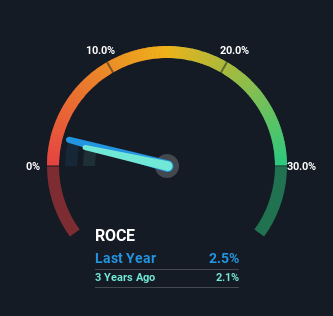- United States
- /
- Professional Services
- /
- NYSE:DNB
We Like These Underlying Return On Capital Trends At Dun & Bradstreet Holdings (NYSE:DNB)

What are the early trends we should look for to identify a stock that could multiply in value over the long term? Ideally, a business will show two trends; firstly a growing return on capital employed (ROCE) and secondly, an increasing amount of capital employed. Basically this means that a company has profitable initiatives that it can continue to reinvest in, which is a trait of a compounding machine. Speaking of which, we noticed some great changes in Dun & Bradstreet Holdings' (NYSE:DNB) returns on capital, so let's have a look.
Return On Capital Employed (ROCE): What Is It?
If you haven't worked with ROCE before, it measures the 'return' (pre-tax profit) a company generates from capital employed in its business. To calculate this metric for Dun & Bradstreet Holdings, this is the formula:
Return on Capital Employed = Earnings Before Interest and Tax (EBIT) ÷ (Total Assets - Current Liabilities)
0.025 = US$200m ÷ (US$9.0b - US$935m) (Based on the trailing twelve months to June 2024).
So, Dun & Bradstreet Holdings has an ROCE of 2.5%. Ultimately, that's a low return and it under-performs the Professional Services industry average of 14%.
Check out our latest analysis for Dun & Bradstreet Holdings

In the above chart we have measured Dun & Bradstreet Holdings' prior ROCE against its prior performance, but the future is arguably more important. If you'd like to see what analysts are forecasting going forward, you should check out our free analyst report for Dun & Bradstreet Holdings .
What Does the ROCE Trend For Dun & Bradstreet Holdings Tell Us?
While in absolute terms it isn't a high ROCE, it's promising to see that it has been moving in the right direction. The data shows that returns on capital have increased substantially over the last five years to 2.5%. The company is effectively making more money per dollar of capital used, and it's worth noting that the amount of capital has increased too, by 39%. This can indicate that there's plenty of opportunities to invest capital internally and at ever higher rates, a combination that's common among multi-baggers.
What We Can Learn From Dun & Bradstreet Holdings' ROCE
In summary, it's great to see that Dun & Bradstreet Holdings can compound returns by consistently reinvesting capital at increasing rates of return, because these are some of the key ingredients of those highly sought after multi-baggers. Given the stock has declined 37% in the last three years, this could be a good investment if the valuation and other metrics are also appealing. With that in mind, we believe the promising trends warrant this stock for further investigation.
Since virtually every company faces some risks, it's worth knowing what they are, and we've spotted 2 warning signs for Dun & Bradstreet Holdings (of which 1 is concerning!) that you should know about.
While Dun & Bradstreet Holdings may not currently earn the highest returns, we've compiled a list of companies that currently earn more than 25% return on equity. Check out this free list here.
New: Manage All Your Stock Portfolios in One Place
We've created the ultimate portfolio companion for stock investors, and it's free.
• Connect an unlimited number of Portfolios and see your total in one currency
• Be alerted to new Warning Signs or Risks via email or mobile
• Track the Fair Value of your stocks
Have feedback on this article? Concerned about the content? Get in touch with us directly. Alternatively, email editorial-team (at) simplywallst.com.
This article by Simply Wall St is general in nature. We provide commentary based on historical data and analyst forecasts only using an unbiased methodology and our articles are not intended to be financial advice. It does not constitute a recommendation to buy or sell any stock, and does not take account of your objectives, or your financial situation. We aim to bring you long-term focused analysis driven by fundamental data. Note that our analysis may not factor in the latest price-sensitive company announcements or qualitative material. Simply Wall St has no position in any stocks mentioned.
About NYSE:DNB
Dun & Bradstreet Holdings
Provides business-to-business data and analytics in North America and internationally.
Good value with moderate growth potential.


